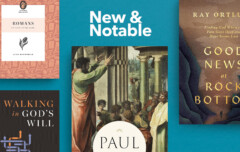This sponsored post was prepared by Professors J. Scott Duvall and J. Daniel Hays on behalf of Zondervan Academic Online Courses.
It’s common for Christians to say they’ve read the Bible their whole lives. But many don’t completely understand what large portions of the Scriptures mean.
3 Bible reading mistakes
Without help, it can be easy to miss out on what the Bible is really saying.
- Many of us approach the Bible with an intuitive or “feels right” approach. We read the text and conclude what we’re thinking or feeling at the time.
- Other times we used a spiritualized approach. We want to force the details of the Bible to provide a spiritual lesson for us—and nothing more.
- Sometimes we just give up.
Does this sound like you?
If we believe that the Bible is God’s Word, then it’s important to learn how to read it well. But this is no small task.
How you can read the Bible better
For years, we watched our students struggle to read the Bible.
Danny had been teaching the Interpreting the Bible class for a few years at Ouachita Baptist University and couldn’t find a satisfactory textbook. Scott suggested that we write one.
We agreed that we needed a book that was more than a simple introduction to Bible study—but not a book that only dealt with highly complex issues of advanced hermeneutics. We wanted to challenge students—but not confuse and discourage them.
We wanted a book that:
- engaged students with clear explanations,
- provided plenty of examples from the Bible itself, and
- gave them hands-on exercises so students could learn by doing.
We wrote Grasping God’s Word over a couple of years with plenty of field testing with our own students to make sure it was just the kind of book that would meet this practical need.
From this book, and from our teaching experience at Ouachita, we developed a course—and now this course is available online for everyone.
We hope it’s as helpful to you as it’s been to the thousands of students who have taken our classes at Ouachita over the years.
The best part is that we are making the first part of this course available for free.
Here is what you will learn in just the first hour:
- How we got our English Bible
- What the major translations are and how they differ
- Approaches to Bible translations
- Why literal Bible translations aren’t always more accurate
- How we can be certain that the Bible is really God’s Word
- Four guidelines for choosing a translations
The course contains a four-part structure:
- The overview gives you an overarching view of the key content. It includes high-quality video lectures to guide you through the material.
- The study page gives you the opportunity to dive deep into the material. Personal reflection questions interspersed throughout the readings will cause you to stop and contemplate the material before moving on.
- The review pages teach you concepts from the unit and keep track of how well you know each concept. You will begin to apply what you learn to actual passages from the Bible.
- The assessment page provides you the opportunity to demonstrate your mastery of the unit’s content.
Remember, it costs nothing to sign up for the first section of the course.
Get started today!
There is nothing like being able to read God’s word for yourself. This free course offers you a clear and concise framework to get started. In only one hour, you’ll know all the basics.












